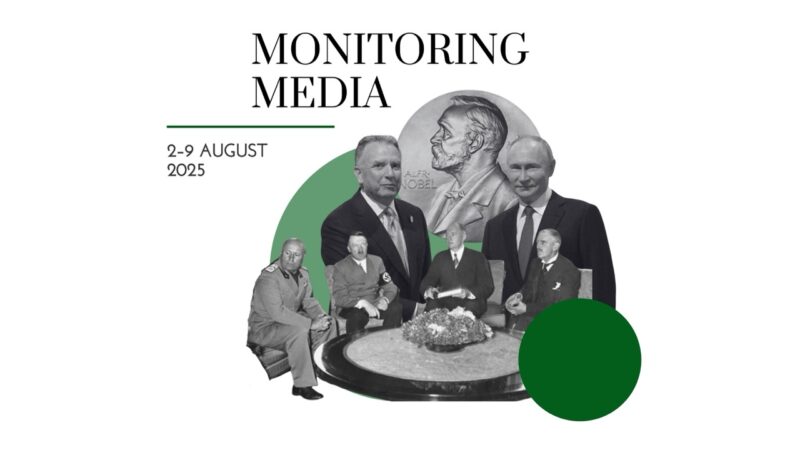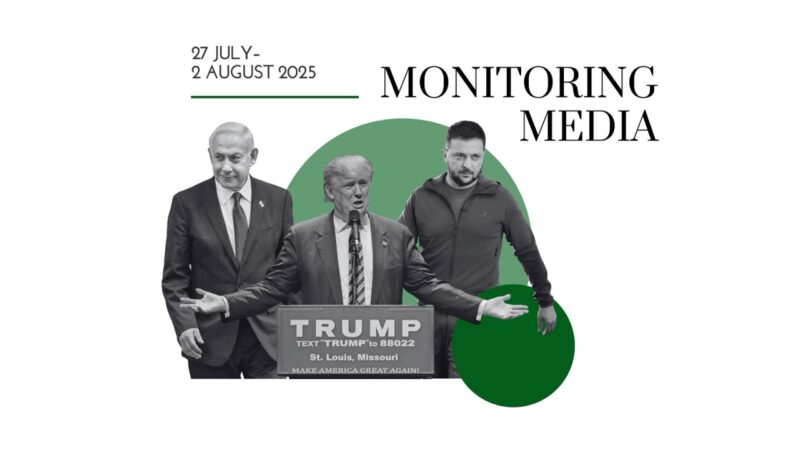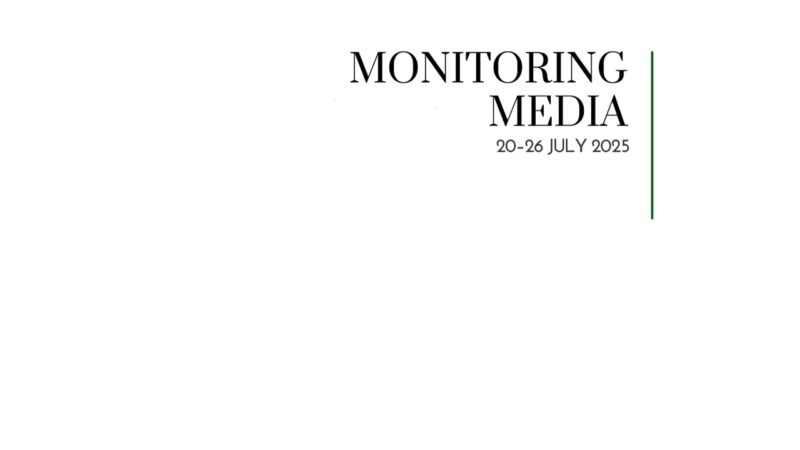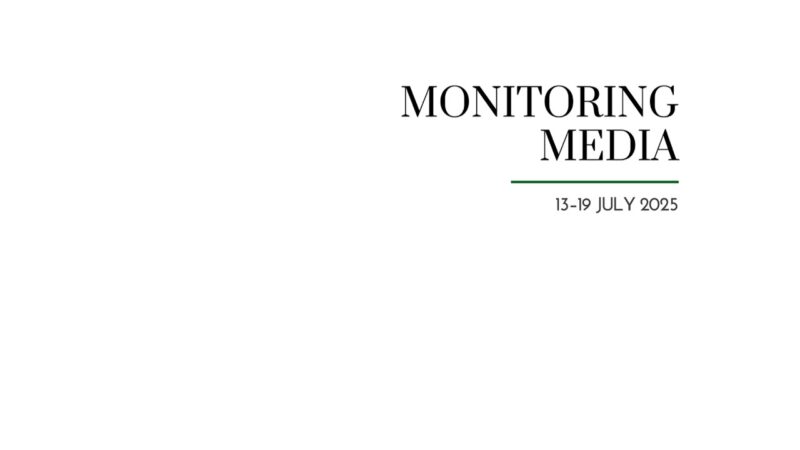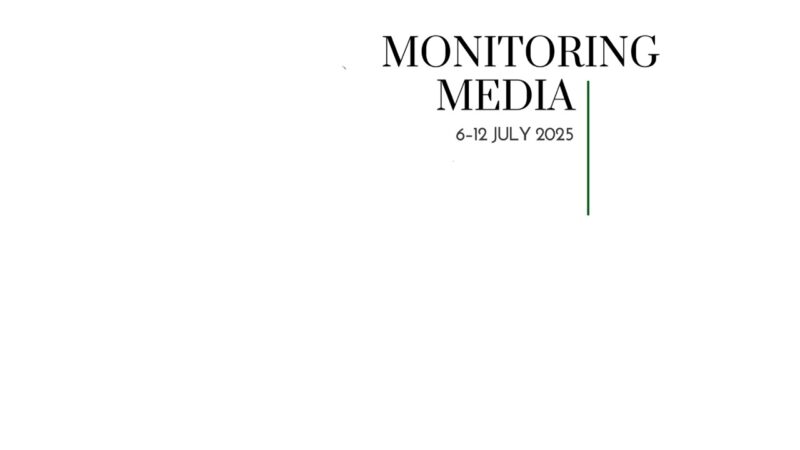Ukraine uses drones to remedy its deficits in raw firepower

CIUS weekly report on North American media coverage of Ukrainian affairs, 12–18 August 2023
Two publications (The Conversation and Politico) were selected to prepare this report on how the situation in Ukraine has been portrayed in the North American press during the past week (12–18 August 2023). The sample was compiled based on their impact on public opinion as well as on their professional reputation, popularity among the readership, and topical relevance. These two publications represent centrist viewpoints on the political spectrum.
This report covers only the most-read and relevant articles about Ukraine, as ranked by the respective North American publications themselves in the past week. Its scope covers promoted articles on home pages and articles from special sections on Ukraine, with the hashtag #Ukraine, from the paper editions of the publications, and about Ukraine from opinion columns and editorials.
Topics featured in the selected articles:
- Ukraine’s current affairs: UAVs are playing a crucial role in Ukraine’s counteroffensive; Ukrainians are believed to be crossing the Dnipro and digging in in the Russian rear; Ukraine actively using social networks to communicate with the Western public; Ukraine joining NATO could end the war;
- The world and Ukraine: US allows training of Ukrainian pilots on F-16s; US Republican Steven Moore declares supporting Ukraine is the right thing to do; China closely observing Russian “adventure” in Ukraine and deciding on its plans regarding Taiwan.
Main arguments:
Drones have become a key element of Ukraine’s armoury and battle tactics. David Hastings Dunn and Stefan Wolff (The Conversation) write about the advantages and limitations of the UAV technology (unmanned aerial vehicles or drones) that Ukraine employs on the battlefield. First, the success of drone attacks on business and government districts in Moscow as well as Novorossiysk—a key Russian port and export hub—demonstrates Ukraine’s ability to strike into the deep rearguard of the enemy. Second, in taking out Russian troops, tanks, ships, and other units in combat, Ukraine expends around 10,000 drones per month. The biggest expense is for the so-called “kamikaze drones”—missile-type UAVs piloted in real time by a human being through first-person-view devices, such as a tablet or a VR headset. Third, the fact itself of Ukraine’s regular attacks on Moscow—which are well-documented and actively circulating on the Internet—brings the war close to ordinary Russians. It also makes the Russians feel insecure, as the vulnerability of the air-defence capacity of their army is exposed. Fourth, successful drone strikes can “boost morale back at home and among Ukraine’s Western partners, at a time when the Ukrainian counteroffensive is making grindingly slow progress.” Fifth, all Ukrainians are able to feel directly affiliated with the war effort through participating in crowdfunding and purchasing drones for their army. Sixth, drones that carry hand grenades and anti-tank warheads scan trike more accurately than artillery fire. They also make the battlefield more transparent because of the real-time stream of visual information to the artillery and mortar units. That being said, still the UAVs “have not been able to have much impact on the deeply-entrenched defences that Russian forces have built up along the 1,200-km-long front in Ukraine. Neither do drones have the same blast capabilities as traditional air power.”
The Ukrainian army is believed to have crossed the Dnipro and established bridgeheads on the occupied bank. Veronika Poniscjakova (The Conversation) opens her article with a statement that “Ukraine’s counteroffensive push has thus far failed to gain the same momentum as their counterattacks last autumn, despite previously high expectations. Kyiv is under considerable international pressure to show results.” In this light, the news about Ukraine crossing the Dnipro River and establishing bridgeheads on the occupied bank may be an important highlight in the ongoing war. According to Poniscjakova, the Russian command expected to use the Dnipro as a natural obstacle to prevent Ukrainian advancement. They also put considerable effort into fortifying the eastern bank of the river in light of Ukraine’s successes on the western bank, particularly the liberation of Kherson. The Russians have done their best to destroy bridges and other structures connecting both banks. Thus, if the news about Ukraine establishing bridgeheads in the east is proven true, this will allow the national army to push further south through Russian-held territory, and a clear path will be opened toward Crimea and the Sea of Azov. In this light, Russia has been reported to move soldiers and equipment in order to reinforce and defend the east-bank Dnipro area. However, these moves have been done very cautiously to prevent failures in other positions, because Ukraine has also increased pressure in the Luhansk region, northeast of Donetsk, and in the western Zaporizhia region. Poniscjakova concludes that Ukraine is advancing slowly but steadily in the occupied territories. That being said, “much will continue to depend on the steadfastness of support from Kyiv’s western allies. There are signs of war-weariness in some countries that were formerly solid supporters of Ukraine—including, for example, Slovakia, where a pro-Kremlin candidate is leading in the polls ahead of next month’s election.”
Ukraine is using Internet communication and social media effectively to promote its war effort. Brandon Boatwright (The Conversation) presents the results of his study of tweets “that the Ukrainian government and the city of Kyiv posted to their official Twitter [today’s X] accounts” between 1 February 2022 and 1 March 2022. Boatwright describes the authorities making 163 posts on the platform in the mentioned time frame and argues that they were used successfully for crisis communication and public diplomacy. In particular, both accounts employ the theme of civic resilience to promote Ukraine’s cause and inform a wider audience about the war. The analyzed posts ranged from fundraising campaigns to appeals for users to “tag @Russia and tell them what you think about them.” Ukrainian authorities also made numerous pleas to their allies in Europe and North America to accept the country into NATO as soon as possible. Apart from that, Ukrainian authorities have actively interacted with Western social media and culture to connect with people in foreign countries in creative ways. For example, they used graphic elements from the official Twitter account of the US television series “The Simpsons” to make a pro-Ukrainian GIF animation. Boatwright concludes that “as the war in Ukraine continues, the government’s strategic use of social media could serve as a model, or at least a point of consideration, to other countries also trying to advance their public images—especially during war and other times of hardship.”
Ukraine joining NATO could end the war. In his opinion article, Tom Malinowski (Politico) argues that there are three most probable ways to end the Russo-Ukrainian war. Two of them depend on acquiescence from the Kremlin, while one bypasses it. The first way entails a complete victory of Ukraine and the full restoration of its sovereign territory. Malinowski considers this to be the best outcome. However, the risks are high: complete victory would likely take years to achieve, and the Russian army appears to be more resilient than expected, Western weapons have not managed to drastically change the tides of war, and Donald Trump’s possible re-ascendancy as POTUS would curtail US support to Ukraine. The second way is by diplomatic agreement: “Earlier this month 40 countries, including China and the United States, met in Saudi Arabia to discuss President Volodymyr Zelensky’s 10-point plan for peace… Any settlement based on that plan would, of course, be wonderful.” However, in the past two decades the Kremlin has never ended its wars at the negotiation table. Malinowski opines that “as long as [Putin’s] military avoids total collapse, and he believes there is a chance of political change in the West, Putin will likely keep sacrificing Russians to stay in the fight.” The third way resides in increasing the supply of weapons to Ukraine, facilitating the reconstruction of liberated territories, and inviting the country to join NATO during the summit in 2024: “Offering Article 5 protection to Ukrainian territory in this fashion would be akin to admitting a divided Germany to NATO after World War II and to America’s security pact with South Korea after the armistice that halted the Korean War without reunifying the Korean Peninsula.” Malinowski argues that Ukraine joining NATO could be how the war ends. The Kremlin would no longer have the luxury to attack the Alliance’s new member, Western sanctions against Russia would remain in place, Putin’s expansionist ambitions would be entirely discredited, and Kyiv would not be restricted in its actions as long as needed to pursue the restoration of its territory.
US finally approves the training of Ukrainian pilots on F-16s. Lara Seligman (Politico) writes that “the Biden administration has formally approved the transfer of F-16 training materials to Denmark, allowing Ukrainian pilots to begin training on the long-anticipated fighter jets.” The transfer of training materials—above all instruction manuals and flight simulators—was the last bureaucratic obstacle in the long-lasting process of strengthening Ukraine’s air power capacity. According to Seligman, this decision signals “a new sense of urgency from Washington to get fighter jets to the battlefield as soon as possible.” In turn, Ukraine has dispatched 32 pilots to take the training, with 24 of them first having to improve their English-language competence. Denmark and the Netherlands are willing to deliver the requested fighter jets to Ukraine immediately once the training of pilots is complete. Still, the Kyiv officials estimate that the jets will not arrive before the end of 2023, meaning they would not be available for the current counteroffensive.
Some US Republicans are directly engaged in Ukraine’s war effort. In a long article, David Phinney (Politico) describes the personal engagement of Steven Moore in Ukraine’s war effort and social resilience. “Moore spent seven years on Capitol Hill working in the House of Representatives mostly as chief of staff for former Rep. Pete Roskam (R-Ill.), the former chief deputy GOP whip. In that role, Moore was one of the most influential staff members on the Republican side of the aisle.” In the first five days of the invasion, Moore initiated the Ukraine Freedom Project, which eventually grew into a quick-response organization that provides medical supplies to hospitals and clinics, as well as generators, radios, and food to civilians struggling on the front lines. In his article, Phinney also highlights that Moore’s fellow Republicans have divided into two camps regarding the Russo-Ukrainian war. The first camp generally shares the Biden administration’s commitment to arm the Ukrainian army and help it fight back. The other camp, “mostly on the party’s nationalist or MAGA wing, are eager to keep the US out of the conflict with complaints of ‘Ukraine fatigue.’” Moore has emerged as one of the most powerful behind-the-scenes advocates for Ukraine in the USA. Phinney lists some of Moore’s views that were voiced during their conversation. First, conservative pundits in American media such as Tucker Carlson play into the hands of Russian narratives and goad voters into attacking their elected representatives with disinformation. Second, Moore believes that Ukrainian authorities are using the delivered equipment very effectively and fighting corruption as much as it is possible in wartime: “This is the best use of foreign aid I have ever seen. Ukraine is getting second-hand weapons—much of it headed to the trash heap—and they’re winning.” Third, with the numerous cases of torture, rape, and murder of the civilian population under Russian occupation, Moore is working on developing a system of paramount importance to monitor and record such crimes. Apart from that, Phinney writes about Moore’s engagement in supplying parts needed for body armour manufacturing, employment programs for talented Ukrainian engineers and skilled workers, supporting Ukrainian refugees in specially designated “safe houses,” humanitarian shipments to frontline cities, and other activities.
Security of Taiwan determined to a large extent by the progress of the Russo-Ukrainian war. Peter Rutland (The Conversation) writes that the failing Russian venture in Ukraine may warn China not to take aggressive action against Taiwan. The US is concerned that President Xi Jinping is determined to gain control over the breakaway province before his tenure ends: “Such fears have been heightened by the fact that China has stepped up its probes of Taiwan’s defenses over the past year.” That being said, there is no unanimity among analysts on whether Beijing will actually deploy its troops. Factors in favour include evidence that the Western economic sanctions for the aggression may not be as devastating as expected; the case of Russia demonstrates that the country may endure much of its foreign trade being cut. Apart from that, the citizens of Taiwan seem to be less motivated to defend their political autonomy compared to Ukrainians. Finally, the US may be too deeply engaged in the situation with Ukraine to spare enough equipment and attention for Taiwan if China takes action. Factors against argue that “Russia’s failure to achieve victory in Ukraine makes it less likely that Xi would gamble on the use of military force to occupy Taiwan. Also, the new generation of weapons that Taiwan possesses, especially drones, boosts defensive capacities and is proving to be effective against the more conventional weapons that constitute the core of the Russian and Chinese armies. Apart from that, with the escalated Russian invasion, the Western countries and many of their Asian partners stood up to support Ukraine and rallied against Russia; thus, the government in Beijing is likely worried about possible isolation. Finally, the longer the Russian invasion lasts, the weaker grip over the country the government in the Kremlin has; this is a worrying development for China. Rutland concludes that “China seemingly wants to see an end to the Ukraine war, but on terms acceptable to its ally, Moscow. China has accepted Russia’s narrative that NATO is to blame for the war, but still pays lip service to the importance of respecting Ukraine’s sovereignty and territorial integrity. Those principles are central to the ‘One China’ policy and Beijing’s claim to sovereignty over Taiwan.”

